 Journal of Service Science and Management, 2011, 4, 291-299 doi:10.4236/jssm.2011.43035 Published Online September 2011 (http://www.SciRP.org/journal/jssm) Copyright © 2011 SciRes. JSSM 291 A Study on Communication Media Selection: Comparing the Effectiveness of the Media Richness, Social Influence, and Media Fitness Rui Gu1, Kunihiko Higa2, Douglas R. Moodie3 1Dalian Maritime University, Dalian, China; 2Tokyo Institute of Technology, Tokyo, Japan; 3Michael J. Coles College of Business, Kennesaw State University, Kennesaw, USA. Email: gurui@dlmu.edu.cn, khiga@craft.titech.ac.jp, dmoodie@coles2.kennesaw.edu Received March 4th, 2011; revised May 6th, 2011; accepted May 25th, 2011. ABSTRACT Media selection has become a more complex problem because of the fast development of Information and Communica- tion Technology. However, there is little quantified work on the tools for media selection decisions. The three main tools available are Media Richness Theory (MRT) [1], Social Influence Perspectives (SIP) [2], and Media Fitness Framework (MFF) [3,4]. MFF is a combination of the factors from MRT and SIP with additional factors for environ- mental and resource limitations. In th is research , we tested the effectiven ess of media selection pred iction of these three tools on 72 communication tasks from 18 companies. We then compared the results to real data. This comparison showed MFF to be more effective than either MRT or SIP, particularly in multiple-media situations. MFF also had a faster converg e nce o f me dia selection p rediction. Keywords: Media Selection, Media Fitness, Media Richness, Social Influence, Effectiveness Comparison 1. Introduction Computer-Mediated Communication (CMC) and other such new technologies have not only brought us new communication tools, but also increased the complexity of the media selection decision. As information exchange has increased in both volume and speed, media selection has become a prominent issue. As Rice pointed out, the resulting effect on medium selection is profound, espe- cially for new communication media [5]. However, re- search on the behavior of media selection is behind the development of media usage. There is no dominating theory in the media selection field that can provide even a basic explanation for simple questions like; “Which medium is better?” or “Should I change my communica- tion media?” Until now, media selection theories divide into two camps. One was the rational camp, which suggested that managers select media rationally by comparing the inner attributes of each communication medium. The most representative theory in this camp is Media Richness Theory (MRT) [1,6]. The other camp was the social in- fluence camp, which posits that managers consider social influences when selecting media. One of the most im- portant theories in the social influence camp is Social Influence Perspective (SIP) [2,7]. Researchers have done empirical studies to support or deny the theories of both camps. This conflicting and contradictory situation in the research on media selection field led to Higa and Gu put- ting forward a more recent theory. Their Media Fitness Framework (MFF) [3,4] took the best from both camps and proposed the task-media fit hypothesis to provide an answer for old and new communication media selection. The aim of this research is to test the effectiveness of MFF by comparing the theoretical predictive ability of MFF, MRT, and SIP on real communication tasks. This paper starts by reviewing MRT, SIP, and MFF. Then it discusses the research method that we used. After that, the paper analyzes the collected data, and gives our re- sults and conclusion s. Finally, we suggest future research, together with the practical limitations in interpreting the conclusions o f t he pa p er. 2. Review of MRT, SIP, and MFF 2.1. Media Richness Theory Daft and Lengel propo sed the Med ia Richness Theo ry [1, 6], which is one of the most famous and widely cited 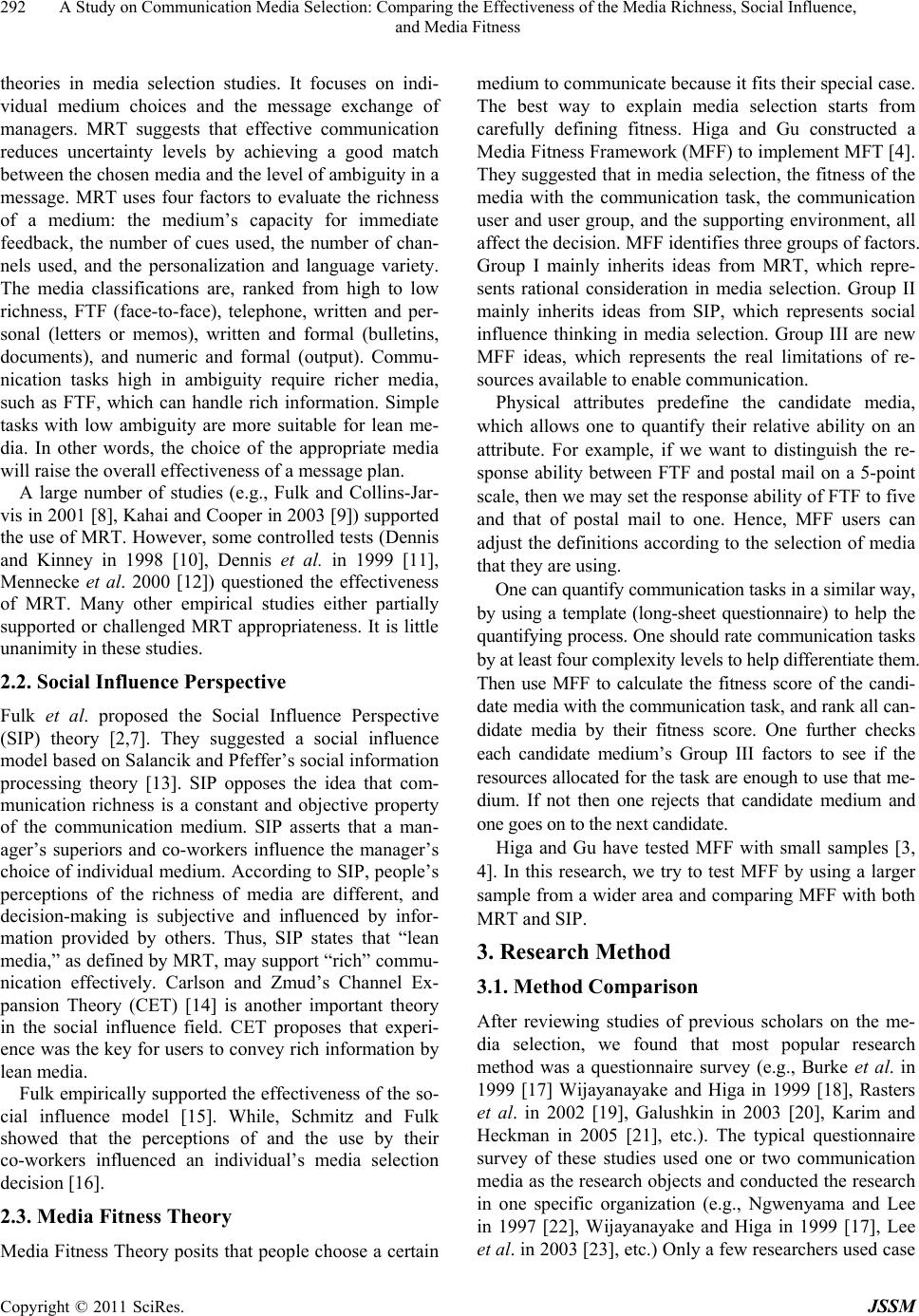 A Study on Communication Media Selection: Comparing the Effectiveness of the Media Ri c hness, Social Influence, 292 and Media Fitness theories in media selection studies. It focuses on indi- vidual medium choices and the message exchange of managers. MRT suggests that effective communication reduces uncertainty levels by achieving a good match between the chosen media and the level of ambiguity in a message. MRT uses four factors to evaluate the richness of a medium: the medium’s capacity for immediate feedback, the number of cues used, the number of chan- nels used, and the personalization and language variety. The media classifications are, ranked from high to low richness, FTF (face-to-face), telephone, written and per- sonal (letters or memos), written and formal (bulletins, documents), and numeric and formal (output). Commu- nication tasks high in ambiguity require richer media, such as FTF, which can handle rich information. Simple tasks with low ambiguity are more suitable for lean me- dia. In other words, the choice of the appropriate media will raise the overall effectiveness of a message plan. A large number of studies (e.g., Fulk and Collins-Jar- vis in 2001 [8], Kahai and Cooper in 2003 [9]) supported the use of MRT. However, some controlled tests (Dennis and Kinney in 1998 [10], Dennis et al. in 1999 [11], Mennecke et al. 2000 [12]) questioned the effectiveness of MRT. Many other empirical studies either partially supported or challenged MRT appropriateness. It is little unanimity in these studies. 2.2. Social Influence Perspective Fulk et al. proposed the Social Influence Perspective (SIP) theory [2,7]. They suggested a social influence model based on Salancik and Pfeffer’s social information processing theory [13]. SIP opposes the idea that com- munication richness is a constant and objective property of the communication medium. SIP asserts that a man- ager’s superiors and co-workers influence the manager’s choice of individual medium. According to SIP, people’s perceptions of the richness of media are different, and decision-making is subjective and influenced by infor- mation provided by others. Thus, SIP states that “lean media,” as defined by MRT, may support “rich” commu- nication effectively. Carlson and Zmud’s Channel Ex- pansion Theory (CET) [14] is another important theory in the social influence field. CET proposes that experi- ence was the key for users to convey rich information by lean media. Fulk empirically supported the effectiveness of the so- cial influence model [15]. While, Schmitz and Fulk showed that the perceptions of and the use by their co-workers influenced an individual’s media selection decision [16]. 2.3. Media Fitness Theory Media Fitness Theo ry posits that people choose a certain medium to communicate because it fits their special case. The best way to explain media selection starts from carefully defining fitness. Higa and Gu constructed a Media Fitness Framework (MFF) to implement MFT [4]. They suggested th at in media selection, the fitness of the media with the communication task, the communication user and user group, and the supporting environment, all affect the decision. MFF identifies three groups of factors. Group I mainly inherits ideas from MRT, which repre- sents rational consideration in media selection. Group II mainly inherits ideas from SIP, which represents social influence thinking in media selection. Group III are new MFF ideas, which represents the real limitations of re- sources available to enable communication. Physical attributes predefine the candidate media, which allows one to quantify their relative ability on an attribute. For example, if we want to distinguish the re- sponse ability between FTF and postal mail on a 5-point scale, then we may set the response ability of FTF to five and that of postal mail to one. Hence, MFF users can adjust the definitions according to the selection of media that they are using. One can quantify communication tasks in a similar way, by using a template (long-sheet questionnaire) to help the quantifying process. One should rate communication tasks by at least four complexity levels to help differentiate them. Then use MFF to calculate the fitness score of the candi- date media with the communication task, and rank all can- didate media by their fitness score. One further checks each candidate medium’s Group III factors to see if the resources allocated for the task are enough to use that me- dium. If not then one rejects that candidate medium and one goes on to the next candidate. Higa and Gu have tested MFF with small samples [3, 4]. In this research, we try to test MFF by using a larger sample from a wider area and comparing MFF with both MRT and SIP. 3. Research Method 3.1. Method Comparison After reviewing studies of previous scholars on the me- dia selection, we found that most popular research method was a questionnaire survey (e.g., Burke et al. in 1999 [17] Wijayanayake and Higa in 1999 [18], Rasters et al. in 2002 [19], Galushkin in 2003 [20], Karim and Heckman in 2005 [21], etc.). The typical questionnaire survey of these studies used one or two communication media as the research objects and conducted the research in one specific organization (e.g., Ngwenyama and Lee in 1997 [22], Wijayanayake and Higa in 1999 [17], Lee et al. in 2003 [23], etc.) Only a few researchers used case Copyright © 2011 SciRes. JSSM 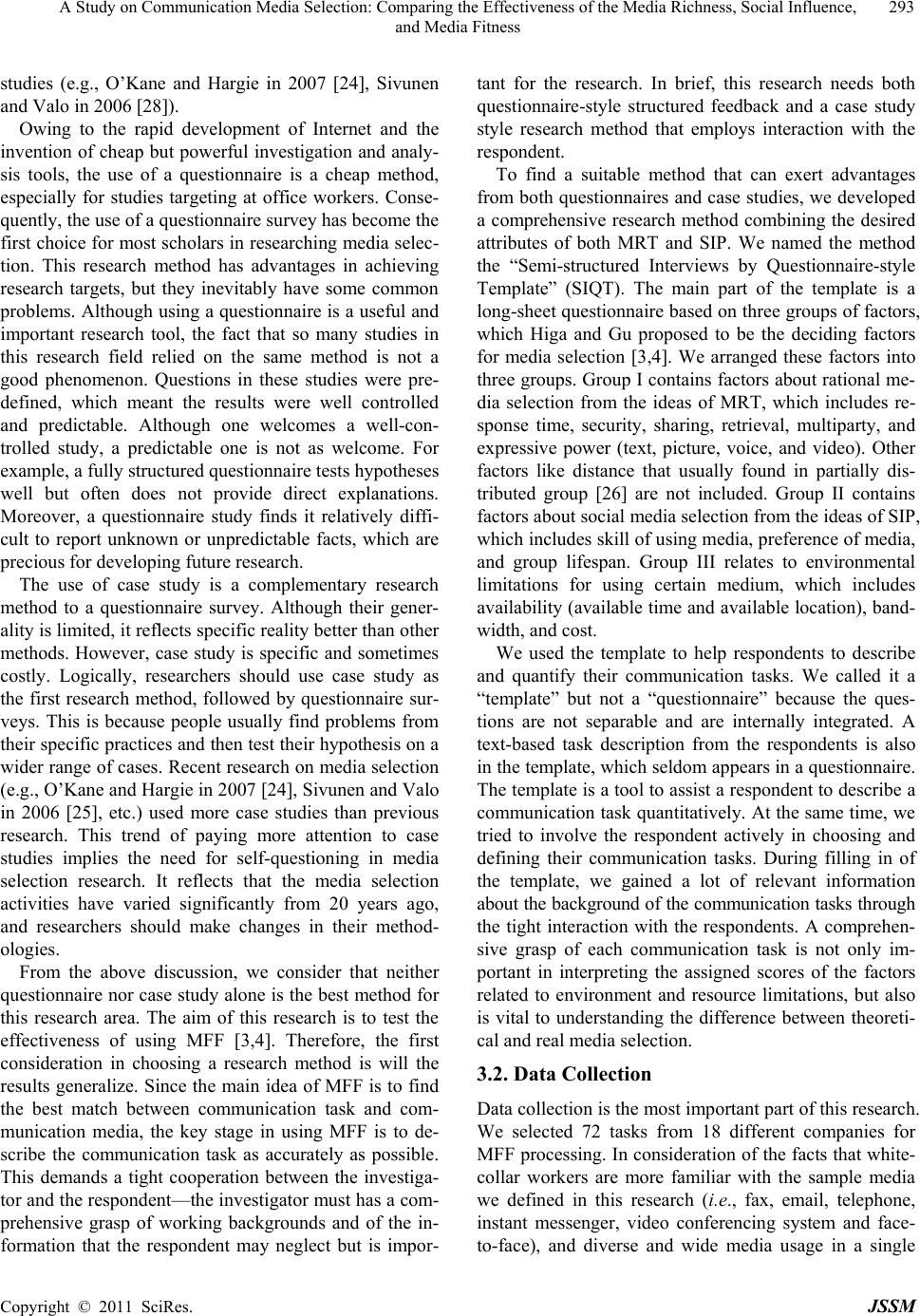 A Study on Communication Media Selection: Comparing the Effectiveness of the Media Ri c hness, Social Influence, 293 and Media Fitness studies (e.g., O’Kane and Hargie in 2007 [24], Sivunen and Valo in 2006 [28]). Owing to the rapid development of Internet and the invention of cheap but powerful investigation and analy- sis tools, the use of a questionnaire is a cheap method, especially for studies targeting at office workers. Conse- quently, the use of a questionn aire survey has become the first choice for most scholars in researching media selec- tion. This research method has advantages in achieving research targets, but they inevitably have some common problems. Although using a qu estionnaire is a useful and important research tool, the fact that so many studies in this research field relied on the same method is not a good phenomenon. Questions in these studies were pre- defined, which meant the results were well controlled and predictable. Although one welcomes a well-con- trolled study, a predictable one is not as welcome. For example, a fully structured questionnaire tests hypotheses well but often does not provide direct explanations. Moreover, a questionnaire study finds it relatively diffi- cult to report unknown or unpredictable facts, which are precious for developing future research. The use of case study is a complementary research method to a questionnaire survey. Although their gener- ality is limited, it reflects specific reality better th an other methods. However, case study is specific and sometimes costly. Logically, researchers should use case study as the first research method, followed by questionnaire sur- veys. This is because people usually find problems from their specific practices and then test their hypothesis on a wider range of cases. Recent research on media selection (e.g., O’Kane and Hargie in 2007 [24], Sivunen and Valo in 2006 [25], etc.) used more case studies than previous research. This trend of paying more attention to case studies implies the need for self-questioning in media selection research. It reflects that the media selection activities have varied significantly from 20 years ago, and researchers should make changes in their method- ologies. From the above discussion, we consider that neither questionnaire nor case study alone is the best method for this research area. The aim of this research is to test the effectiveness of using MFF [3,4]. Therefore, the first consideration in choosing a research method is will the results generalize. Since the main idea of MFF is to find the best match between communication task and com- munication media, the key stage in using MFF is to de- scribe the communication task as accurately as possible. This demands a tight cooperation between the investiga- tor and the respondent—the investigator must has a com- prehensive grasp of working backgrounds and of the in- formation that the respondent may neglect but is impor- tant for the research. In brief, this research needs both questionnaire-style structured feedback and a case study style research method that employs interaction with the respondent. To find a suitable method that can exert advantages from both questionnaires and case studies, we developed a comprehensive research method combining the desired attributes of both MRT and SIP. We named the method the “Semi-structured Interviews by Questionnaire-style Template” (SIQT). The main part of the template is a long-sheet questionnaire based on three groups of factors, which Higa and Gu proposed to be the deciding factors for media selection [3,4]. We arranged these factors into three groups. Group I contains factors about rational me- dia selection from the ideas of MRT, which includes re- sponse time, security, sharing, retrieval, multiparty, and expressive power (text, picture, voice, and video). Other factors like distance that usually found in partially dis- tributed group [26] are not included. Group II contains factors about social media selection from the ideas of SIP, which includes skill o f using media, pr eference of media, and group lifespan. Group III relates to environmental limitations for using certain medium, which includes availability (available time and av ailable location), band- width, and cost. We used the template to help respondents to describe and quantify their communication tasks. We called it a “template” but not a “questionnaire” because the ques- tions are not separable and are internally integrated. A text-based task description from the respondents is also in the template, which seldo m appears in a questionnaire. The template is a tool to assist a respondent to describe a communication task qu antitatively. At the same time, we tried to involve the respondent actively in choosing and defining their communication tasks. During filling in of the template, we gained a lot of relevant information about the background of the communication tasks through the tight interaction with the respondents. A comprehen- sive grasp of each communication task is not only im- portant in interpreting the assigned scores of the factors related to environment and resource limitations, but also is vital to understanding the difference between theoreti- cal and real media selection. 3.2. Data Collection Data collection is the most important part of this research. We selected 72 tasks from 18 different companies for MFF processing. In consideration of th e facts that white- collar workers are more familiar with the sample media we defined in this research (i.e., fax, email, telephone, instant messenger, video conferencing system and face- to-face), and diverse and wide media usage in a single Copyright © 2011 SciRes. JSSM 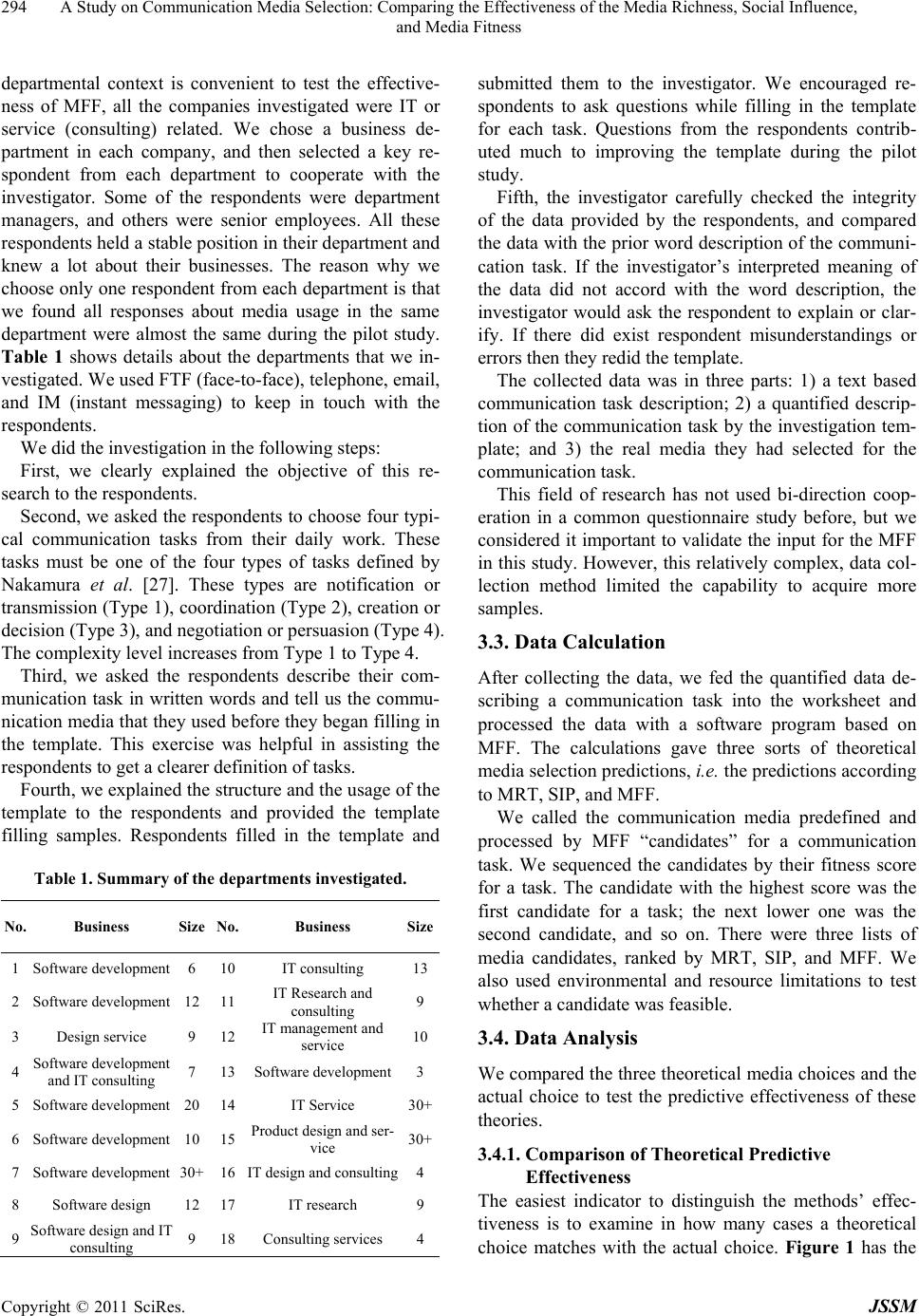 A Study on Communication Media Selection: Comparing the Effectiveness of the Media Ri c hness, Social Influence, 294 and Media Fitness departmental context is convenient to test the effective- ness of MFF, all the companies investigated were IT or service (consulting) related. We chose a business de- partment in each company, and then selected a key re- spondent from each department to cooperate with the investigator. Some of the respondents were department managers, and others were senior employees. All these respondents held a stable position in their department and knew a lot about their businesses. The reason why we choose only one respondent from each department is that we found all responses about media usage in the same department were almost the same during the pilot study. Table 1 shows details about the departments that we in- vestigated. We used FTF (face-to-face), telephone, email, and IM (instant messaging) to keep in touch with the respondents. We did the investigation in the following steps: First, we clearly explained the objective of this re- search to the respondents. Second, we asked the responden ts to choose four typi- cal communication tasks from their daily work. These tasks must be one of the four types of tasks defined by Nakamura et al. [27]. These types are notification or transmission (Type 1), coordination (Type 2), creation or decision (Type 3), and negotiation or persuasion (Type 4). The complexity level increases fro m Type 1 to Type 4. Third, we asked the respondents describe their com- munication task in written words and tell us the commu- nication media that they us ed before they began filling in the template. This exercise was helpful in assisting the respondents to get a clearer definition of tasks. Fourth, we explained the structure and the usage of the template to the respondents and provided the template filling samples. Respondents filled in the template and Table 1. Summary of the departments investigated. No. Business Size No.Business Size 1 Software development 6 10IT consulting 13 2 Software development 12 11IT Research and consulting 9 3 Design service 9 12IT management and service 10 4 Software development and IT consulting 7 13Software development3 5 Software development 20 14IT Se rvice 30+ 6 Software development 10 15Product design and ser- vice 30+ 7 Software development 30+ 16IT design and consulting4 8 Software design 12 17IT research 9 9 Software design and IT consulting 9 18Consulting services 4 submitted them to the investigator. We encouraged re- spondents to ask questions while filling in the template for each task. Questions from the respondents contrib- uted much to improving the template during the pilot study. Fifth, the investigator carefully checked the integrity of the data provided by the respondents, and compared the data with the prior word description of the communi- cation task. If the investigator’s interpreted meaning of the data did not accord with the word description, the investigator would ask the respondent to explain or clar- ify. If there did exist respondent misunderstandings or errors then they red id the template. The collected data was in three parts: 1) a text based communication task description; 2) a quantified descrip- tion of the communication task by the investigation tem- plate; and 3) the real media they had selected for the communication task. This field of research has not used bi-direction coop- eration in a common questionnaire study before, but we considered it important to validate the input for the MFF in this study. However, th is relatively complex, data col- lection method limited the capability to acquire more samples. 3.3. Data Calculation After collecting the data, we fed the quantified data de- scribing a communication task into the worksheet and processed the data with a software program based on MFF. The calculations gave three sorts of theoretical media selection predictions, i.e. the predictions according to MRT, SIP, and MFF. We called the communication media predefined and processed by MFF “candidates” for a communication task. We sequenced the candidates by their fitness score for a task. The candidate with the highest score was the first candidate for a task; the next lower one was the second candidate, and so on. There were three lists of media candidates, ranked by MRT, SIP, and MFF. We also used environmental and resource limitations to test whether a candidate was feasible. 3.4. Data Analysis We compared the three theoretical media choices and the actual choice to test the predictive effectiveness of these theories. 3.4.1. Comparison of Theore tical Predictive Effectiveness The easiest indicator to distinguish the methods’ effec- tiveness is to examine in how many cases a theoretical choice matches with the actual choice. Figure 1 has the Copyright © 2011 SciRes. JSSM 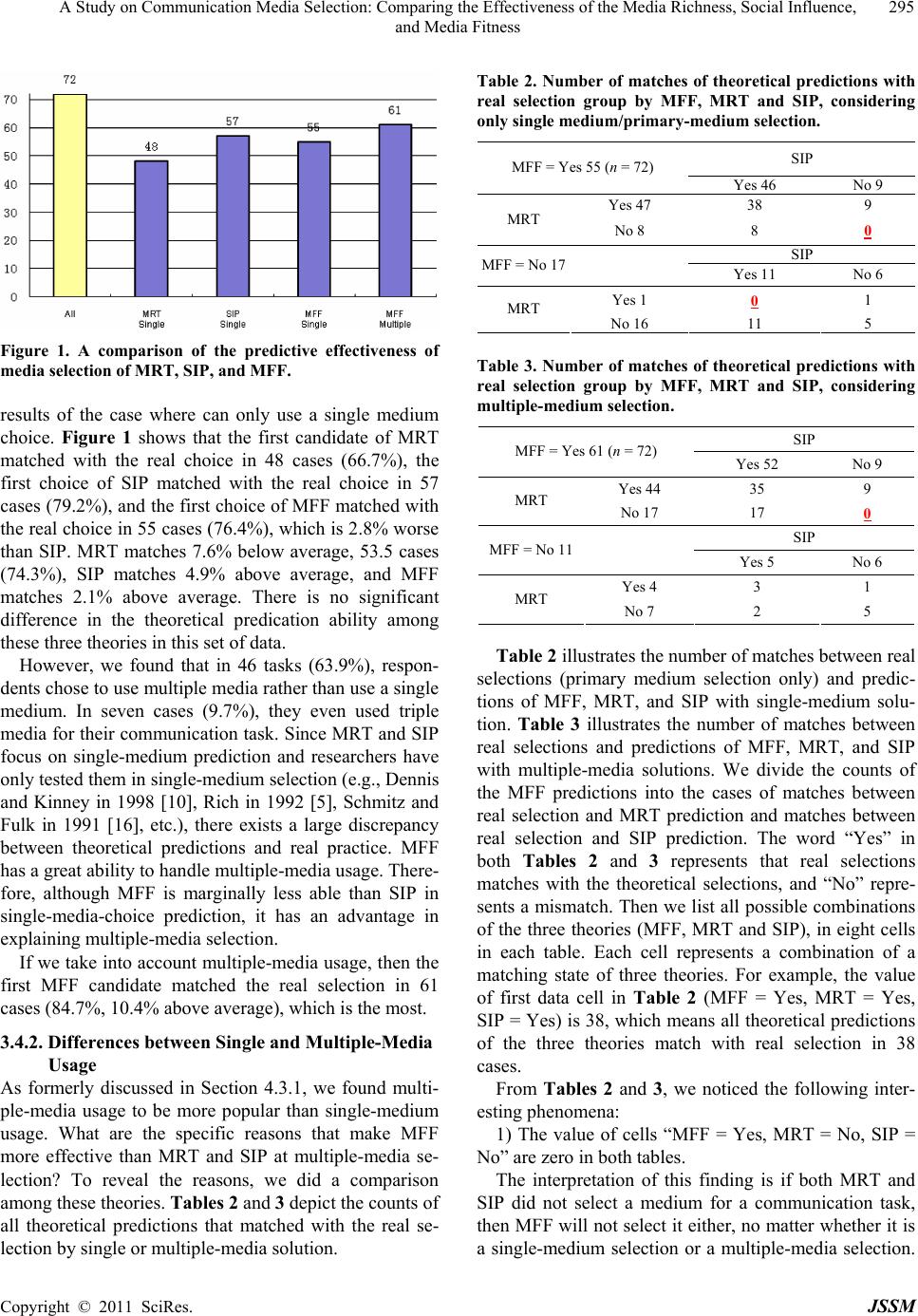 A Study on Communication Media Selection: Comparing the Effectiveness of the Media Ri c hness, Social Influence, 295 and Media Fitness Figure 1. A comparison of the predictive effectiveness of media selection of MRT, SIP, and M FF. results of the case where can only use a single medium choice. Figure 1 shows that the first candidate of MRT matched with the real choice in 48 cases (66.7%), the first choice of SIP matched with the real choice in 57 cases (79.2%), and the first choice of MFF matched with the real choice in 55 cases (76.4%), which is 2.8% worse than SIP. MRT matches 7.6% below average, 53.5 cases (74.3%), SIP matches 4.9% above average, and MFF matches 2.1% above average. There is no significant difference in the theoretical predication ability among these three theories in this set of data. However, we found that in 46 tasks (63.9%), respon- dents cho se to use multiple med ia rather than use a single medium. In seven cases (9.7%), they even used triple media for their communication task. Since MRT and SIP focus on single-medium prediction and researchers have only tested them in single-medium selection (e.g., Dennis and Kinney in 1998 [10], Rich in 1992 [5], Schmitz and Fulk in 1991 [16], etc.), there exists a large discrepancy between theoretical predictions and real practice. MFF has a great ability to handle multip le-media usage. There- fore, although MFF is marginally less able than SIP in single-media-choice prediction, it has an advantage in explaining multiple-media selection. If we take into account multiple-media usage, then the first MFF candidate matched the real selection in 61 cases (84.7%, 10.4% above average), which is the most. 3.4.2. Differences between Single and Multiple-Media Usage As formerly discussed in Section 4.3.1, we found multi- ple-media usage to be more popular than single-medium usage. What are the specific reasons that make MFF more effective than MRT and SIP at multiple-media se- lection? To reveal the reasons, we did a comparison among these theories. Tables 2 and 3 depict the counts of all theoretical predictions that matched with the real se- lection by single or multiple-media solu tion. Table 2. Number of matches of theoretical predictions with real selection group by MFF, MRT and SIP, considering only single medium/primary-medium selection. SIP MFF = Yes 55 (n = 72) Yes 46 No 9 Yes 47 38 9 MRT No 8 8 0 SIP MFF = No 17 Yes 11 No 6 Yes 1 0 1 MRT No 16 11 5 Table 3. Number of matches of theoretical predictions with real selection group by MFF, MRT and SIP, considering multiple-medium selection. SIP MFF = Yes 61 (n = 72) Yes 52 No 9 Yes 44 35 9 MRT No 17 17 0 SIP MFF = No 11 Yes 5 No 6 Yes 4 3 1 MRT No 7 2 5 Table 2 illustrates the number of matches between real selections (primary medium selection only) and predic- tions of MFF, MRT, and SIP with single-medium solu- tion. Table 3 illustrates the number of matches between real selections and predictions of MFF, MRT, and SIP with multiple-media solutions. We divide the counts of the MFF predictions into the cases of matches between real selection and MRT prediction and matches between real selection and SIP prediction. The word “Yes” in both Tables 2 and 3 represents that real selections matches with the theoretical selections, and “No” repre- sents a mismatch. Then we list all possible combinations of the three theories (MFF, MRT and SIP), in eight cells in each table. Each cell represents a combination of a matching state of three theories. For example, the value of first data cell in Table 2 (MFF = Yes, MRT = Yes, SIP = Yes) is 38, which means all theoretical predictions of the three theories match with real selection in 38 cases. From Tables 2 and 3, we noticed the following inter- esting phenomena: 1) The value of cells “MFF = Yes, MRT = No, SIP = No” are zero in both tables. The interpretation of this finding is if both MRT and SIP did not select a medium for a communication task, then MFF will not select it either, no matter whether it is a single-medium selection or a multiple-media selection. Copyright © 2011 SciRes. JSSM 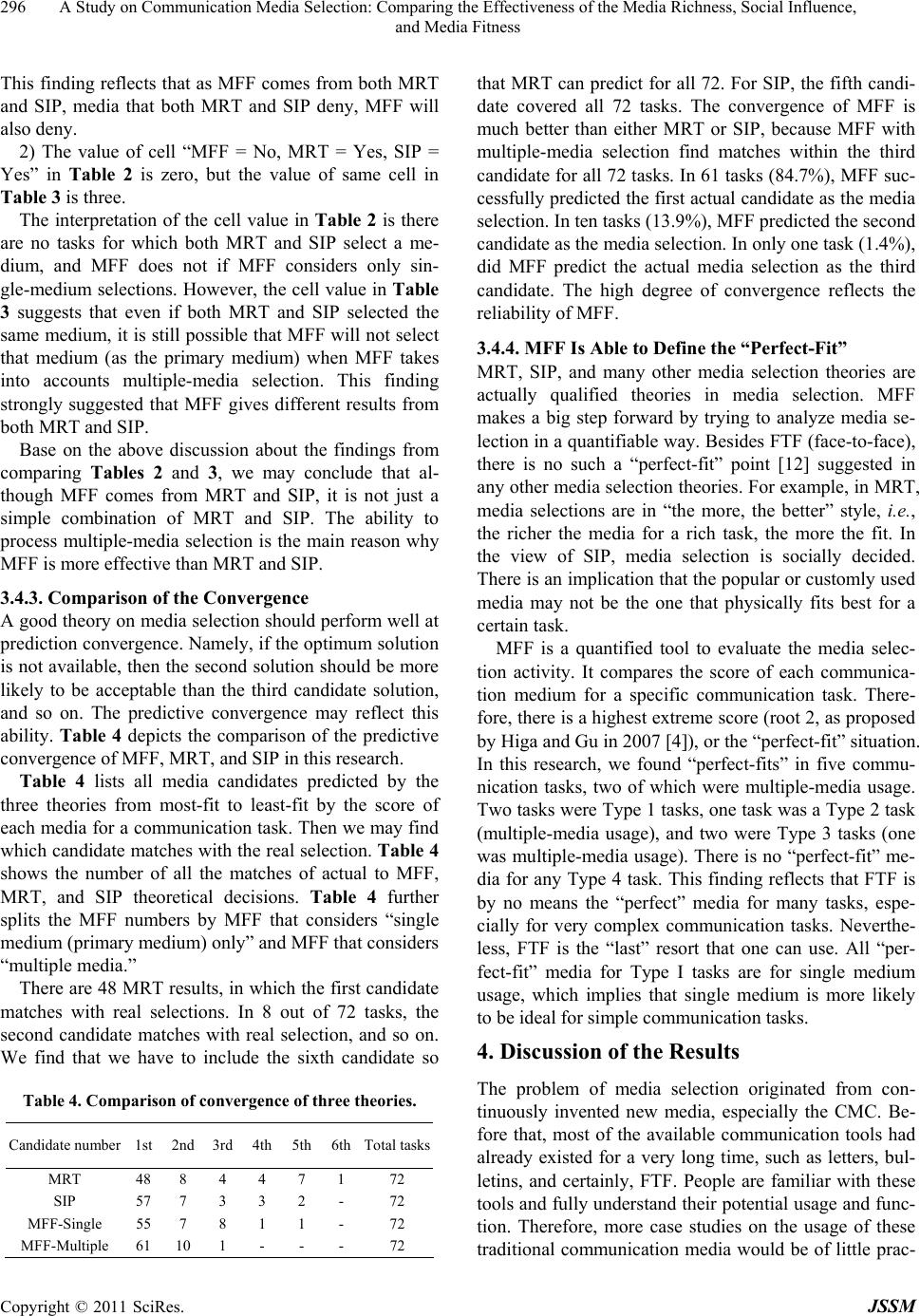 A Study on Communication Media Selection: Comparing the Effectiveness of the Media Ri c hness, Social Influence, 296 and Media Fitness This finding reflects that as MFF comes from both MRT and SIP, media that both MRT and SIP deny, MFF will also deny. 2) The value of cell “MFF = No, MRT = Yes, SIP = Yes” in Table 2 is zero, but the value of same cell in Table 3 is three. The interpretation of the cell value in Table 2 is there are no tasks for which both MRT and SIP select a me- dium, and MFF does not if MFF considers only sin- gle-medium selections. However, the cell value in Table 3 suggests that even if both MRT and SIP selected the same medium, it is still possible that MFF will not select that medium (as the primary medium) when MFF takes into accounts multiple-media selection. This finding strongly suggested that MFF gives different results from both MRT and SIP. Base on the above discussion about the findings from comparing Tables 2 and 3, we may conclude that al- though MFF comes from MRT and SIP, it is not just a simple combination of MRT and SIP. The ability to process multiple-media selection is the main reason why MFF is more effective than MRT and SIP. 3.4.3. Comp a rison of the Convergence A good theory on media selection should perform well at prediction conv ergence. Namely, if the optimum solutio n is not available, then th e second solution should be more likely to be acceptable than the third candidate solution, and so on. The predictive convergence may reflect this ability. Table 4 depicts the comparison of the predictive convergence of MFF, MRT, and SIP in this research. Table 4 lists all media candidates predicted by the three theories from most-fit to least-fit by the score of each media for a communication task. Then we may find which candidate matches with the real selection. Table 4 shows the number of all the matches of actual to MFF, MRT, and SIP theoretical decisions. Table 4 further splits the MFF numbers by MFF that considers “single medium (primary medium) only” and MFF that considers “multiple media.” There are 48 MRT results, in which the first cand idate matches with real selections. In 8 out of 72 tasks, the second candidate matches with real selection, and so on. We find that we have to include the sixth candidate so Table 4. Comparison of convergence of three theories. Candidate number 1st 2nd 3rd4th 5th 6th Total tasks MRT 48 8 4 4 7 1 72 SIP 57 7 3 3 2 - 72 MFF-Single 55 7 8 1 1 - 72 MFF-Multiple 61 10 1 - - - 72 that MRT can predict for all 72. For SIP, the fifth candi- date covered all 72 tasks. The convergence of MFF is much better than either MRT or SIP, because MFF with multiple-media selection find matches within the third candidate for all 72 tasks. In 61 tasks (84.7%), MFF suc- cessfully predicted the first actual can didate as the media selection. In ten tasks (13.9%), MFF predicted the second candidate as the media selection. In only one task (1.4%), did MFF predict the actual media selection as the third candidate. The high degree of convergence reflects the reliability of MFF. 3.4.4. MFF Is Able to Define the “Perfect-Fit” MRT, SIP, and many other media selection theories are actually qualified theories in media selection. MFF makes a big step forward by trying to analyze media se- lection in a quantifiable way. Besides FTF (face-to-face), there is no such a “perfect-fit” point [12] suggested in any other media selection theories. For example, in MRT, media selections are in “the more, the better” style, i.e., the richer the media for a rich task, the more the fit. In the view of SIP, media selection is socially decided. There is an implication that the popular or custo mly used media may not be the one that physically fits best for a certain task. MFF is a quantified tool to evaluate the media selec- tion activity. It compares the score of each communica- tion medium for a specific communication task. There- fore, there is a highest extreme score (root 2, as proposed by Higa and Gu in 2007 [4]), or the “perfect-fit” situation. In this research, we found “perfect-fits” in five commu- nication tasks, two of which were multiple-media usage. Two tasks were Type 1 tasks, one task was a Type 2 task (multiple-media usage), and two were Type 3 tasks (one was multiple-media usage). There is no “perfect-fit” me- dia for any Type 4 task. This finding reflects that FTF is by no means the “perfect” media for many tasks, espe- cially for very complex communication tasks. Neverthe- less, FTF is the “last” resort that one can use. All “per- fect-fit” media for Type I tasks are for single medium usage, which implies that single medium is more likely to be ideal for simple communication tasks. 4. Discussion of the Results The problem of media selection originated from con- tinuously invented new media, especially the CMC. Be- fore that, most of the available communication tools had already existed for a very long time, such as letters, bul- letins, and certainly, FTF. People are familiar with these tools and fully understand their potential usage and func- tion. Therefore, more case studies on the usage of these traditional communication media would be of little prac- Copyright © 2011 SciRes. JSSM 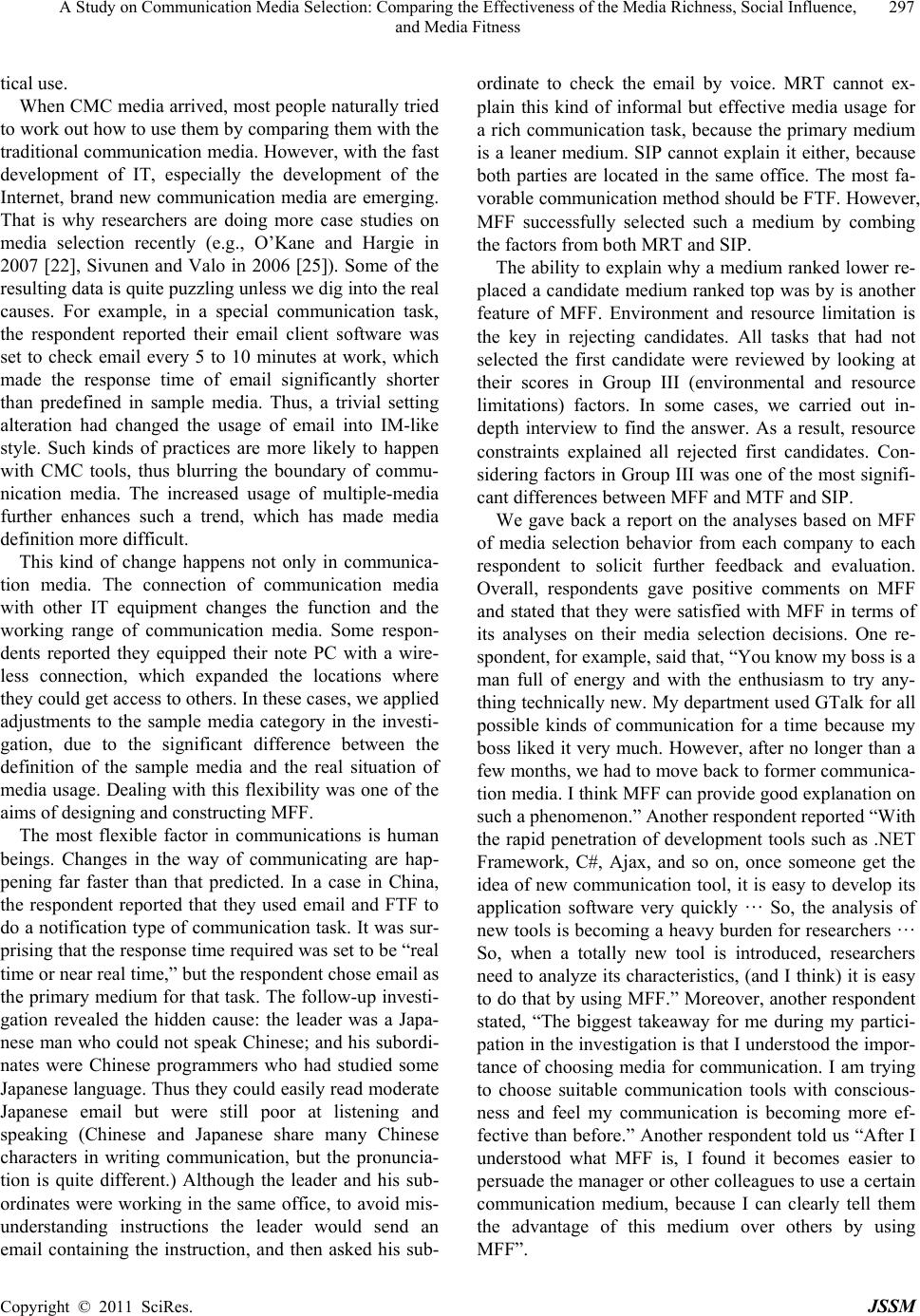 A Study on Communication Media Selection: Comparing the Effectiveness of the Media Ri c hness, Social Influence, 297 and Media Fitness tical use. When CMC media arrived, most people naturally tried to work out how to use them by comparing them with the traditional communication media. However, with the fast development of IT, especially the development of the Internet, brand new communication media are emerging. That is why researchers are doing more case studies on media selection recently (e.g., O’Kane and Hargie in 2007 [22], Sivunen and Valo in 2006 [25]). Some of the resulting data is quite puzzling unless we dig into the real causes. For example, in a special communication task, the respondent reported their email client software was set to check email every 5 to 10 minutes at work, which made the response time of email significantly shorter than predefined in sample media. Thus, a trivial setting alteration had changed the usage of email into IM-like style. Such kinds of practices are more likely to happen with CMC tools, thus blurring the boundary of commu- nication media. The increased usage of multiple-media further enhances such a trend, which has made media definition more difficult. This kind of change happens not only in communica- tion media. The connection of communication media with other IT equipment changes the function and the working range of communication media. Some respon- dents reported they equipped their note PC with a wire- less connection, which expanded the locations where they could get access to others. In these cases, we applied adjustments to the sample media category in the investi- gation, due to the significant difference between the definition of the sample media and the real situation of media usage. Dealing with this flexibility was one of the aims of designing and constructing MFF. The most flexible factor in communications is human beings. Changes in the way of communicating are hap- pening far faster than that predicted. In a case in China, the respondent reported that they used email and FTF to do a notification type of communication task. It was sur- prising that the response time required was set to be “real time or near real time,” but the respondent chose email as the primary medium for that task. The follow-up investi- gation revealed the hidden cause: the leader was a Japa- nese man who could not speak Chinese; and his subordi- nates were Chinese programmers who had studied some Japanese language. Thus they could easily read moderate Japanese email but were still poor at listening and speaking (Chinese and Japanese share many Chinese characters in writing communication, but the pronuncia- tion is quite different.) Although the leader and his sub- ordinates were working in the same office, to avoid mis- understanding instructions the leader would send an email containing the instruction, and then asked his sub- ordinate to check the email by voice. MRT cannot ex- plain this kind of informal but effective media usage for a rich communication task, because the primary medium is a leaner medium. SIP cannot explain it either, because both parties are located in the same office. The most fa- vorable communication method should be FTF. However, MFF successfully selected such a medium by combing the factors from both MRT and SIP. The ability to explain why a medium ranked lower re- placed a candidate medium ranked top was by is another feature of MFF. Environment and resource limitation is the key in rejecting candidates. All tasks that had not selected the first candidate were reviewed by looking at their scores in Group III (environmental and resource limitations) factors. In some cases, we carried out in- depth interview to find the answer. As a result, resource constraints explained all rejected first candidates. Con- sidering factors in Group III was one of the most signifi- cant differences between MFF and MTF and SIP. We gave back a report on the analyses based on MFF of media selection behavior from each company to each respondent to solicit further feedback and evaluation. Overall, respondents gave positive comments on MFF and stated that they were satisfied with MFF in terms of its analyses on their media selection decisions. One re- spondent, for example, said that, “You know my boss is a man full of energy and with the enthusiasm to try any- thing technically new. My department used GTalk for all possible kinds of communication for a time because my boss liked it very much. However, after no longer than a few months, we had to move back to former communica- tion media. I think MFF can provide good explanation on such a phenomenon.” Another respondent reported “With the rapid penetration of development tools such as .NET Framework, C#, Ajax, and so on, once someone get the idea of new communication tool, it is easy to develop its application software very quickly … So, the analysis of new tools is becoming a heavy burden for researchers … So, when a totally new tool is introduced, researchers need to analyze its characteristics, (and I think) it is easy to do that by using MFF.” Moreover, another respondent stated, “The biggest takeaway for me during my partici- pation in the investigation is that I understood the impor- tance of choosing media for communication. I am trying to choose suitable communication tools with conscious- ness and feel my communication is becoming more ef- fective than before.” Another respondent told us “After I understood what MFF is, I found it becomes easier to persuade the manager or other colleagues to use a certain communication medium, because I can clearly tell them the advantage of this medium over others by using MFF”. Copyright © 2011 SciRes. JSSM 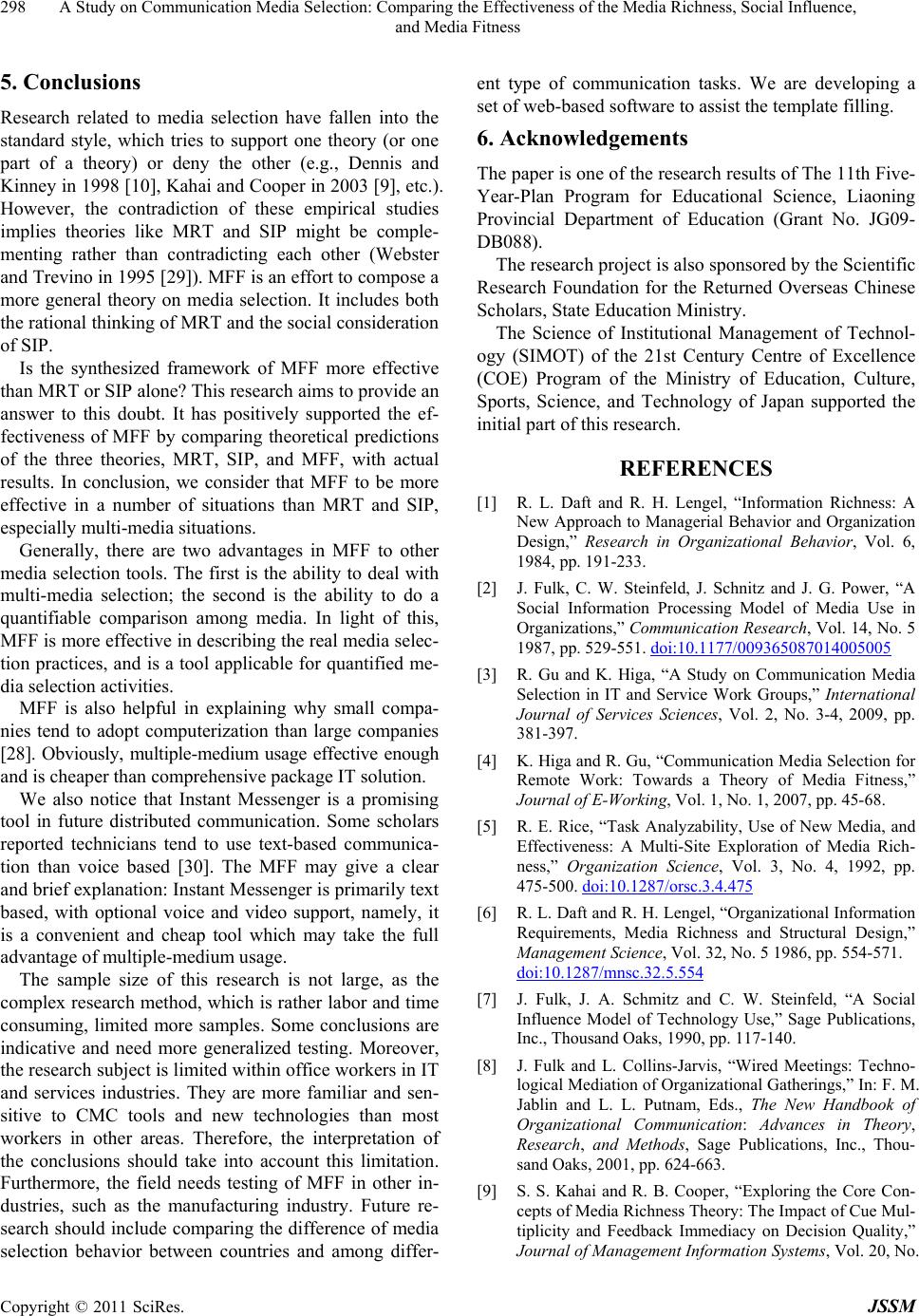 A Study on Communication Media Selection: Comparing the Effectiveness of the Media Ri c hness, Social Influence, 298 and Media Fitness 5. Conclusions Research related to media selection have fallen into the standard style, which tries to support one theory (or one part of a theory) or deny the other (e.g., Dennis and Kinney in 19 98 [10], Ka hai an d Cooper in 2003 [9], etc.). However, the contradiction of these empirical studies implies theories like MRT and SIP might be comple- menting rather than contradicting each other (Webster and Trevino in 1995 [29]). MFF is an eff ort to co mpose a more general theory on media selection. It includes both the rational thinking of MRT and the social consideration of SIP. Is the synthesized framework of MFF more effective than MRT or SIP alone? This research aims to provide an answer to this doubt. It has positively supported the ef- fectiveness of MFF by comparing theoretical predictions of the three theories, MRT, SIP, and MFF, with actual results. In conclusion, we consider that MFF to be more effective in a number of situations than MRT and SIP, especially multi-media situations. Generally, there are two advantages in MFF to other media selection tools. The first is the ability to deal with multi-media selection; the second is the ability to do a quantifiable comparison among media. In light of this, MFF is more effective in describing the real media selec- tion practices, and is a tool applicable for quantified me- dia selection activities. MFF is also helpful in explaining why small compa- nies tend to adopt computerization than large companies [28]. Obviously, multiple-medium usage effective enough and is ch eaper than comp rehensive package IT solution. We also notice that Instant Messenger is a promising tool in future distributed communication. Some scholars reported technicians tend to use text-based communica- tion than voice based [30]. The MFF may give a clear and brief explanation: Instant Messenger is primarily text based, with optional voice and video support, namely, it is a convenient and cheap tool which may take the full advantage of multiple-medium usage. The sample size of this research is not large, as the complex research method, which is rather labor and time consuming, limited more samples. Some conclusions are indicative and need more generalized testing. Moreover, the research subject is limited with in office workers in IT and services industries. They are more familiar and sen- sitive to CMC tools and new technologies than most workers in other areas. Therefore, the interpretation of the conclusions should take into account this limitation. Furthermore, the field needs testing of MFF in other in- dustries, such as the manufacturing industry. Future re- search should include comparing the difference of media selection behavior between countries and among differ- ent type of communication tasks. We are developing a set of web-based software to assist the template filling. 6. Acknowledgements The paper is one of the research results of The 11th Five- Year-Plan Program for Educational Science, Liaoning Provincial Department of Education (Grant No. JG09- DB088). The research project is also sponsored by the Scientific Research Foundation for the Returned Overseas Chinese Scholars, State Education Ministry. The Science of Institutional Management of Technol- ogy (SIMOT) of the 21st Century Centre of Excellence (COE) Program of the Ministry of Education, Culture, Sports, Science, and Technology of Japan supported the initial part of this research. REFERENCES [1] R. L. Daft and R. H. Lengel, “Information Richness: A New Approach to Managerial Behavior and Organization Design,” Research in Organizational Behavior, Vol. 6, 1984, pp. 191-233. [2] J. Fulk, C. W. Steinfeld, J. Schnitz and J. G. Power, “A Social Information Processing Model of Media Use in Organizations,” Communication Research, Vol. 14, No. 5 1987, pp. 529-551. doi:10.1177/009365087014005005 [3] R. Gu and K. Higa, “A Study on Communication Media Selection in IT and Service Work Groups,” International Journal of Services Sciences, Vol. 2, No. 3-4, 2009, pp. 381-397. [4] K. Higa and R. Gu, “Communication Media Selection for Remote Work: Towards a Theory of Media Fitness,” Journal of E-Working, Vol. 1, No. 1, 2007, pp. 45-68. [5] R. E. Rice, “Task Analyzability, Use of New Media, and Effectiveness: A Multi-Site Exploration of Media Rich- ness,” Organization Science, Vol. 3, No. 4, 1992, pp. 475-500. doi:10.1287/orsc.3.4.475 [6] R. L. Daft and R. H. Lengel, “Organizational Information Requirements, Media Richness and Structural Design,” Management Science, Vol. 32, No. 5 1986, pp. 554-571. doi:10.1287/mnsc.32.5.554 [7] J. Fulk, J. A. Schmitz and C. W. Steinfeld, “A Social Influence Model of Technology Use,” Sage Publications, Inc., Thousand Oaks, 1990, pp. 117-140. [8] J. Fulk and L. Collins-Jarvis, “Wired Meetings: Techno- logical Mediation of Organizational Gatherings,” In: F. M. Jablin and L. L. Putnam, Eds., The New Handbook of Organizational Communication: Advances in Theory, Research, and Methods, Sage Publications, Inc., Thou- sand Oaks, 2001, pp. 624-663. [9] S. S. Kahai and R. B. Cooper, “Exploring the Core Con- cepts of Media Richness Theory: The Impact of Cue Mul- tiplicity and Feedback Immediacy on Decision Quality,” Journal of Management Information Systems, Vol. 20, No. Copyright © 2011 SciRes. JSSM 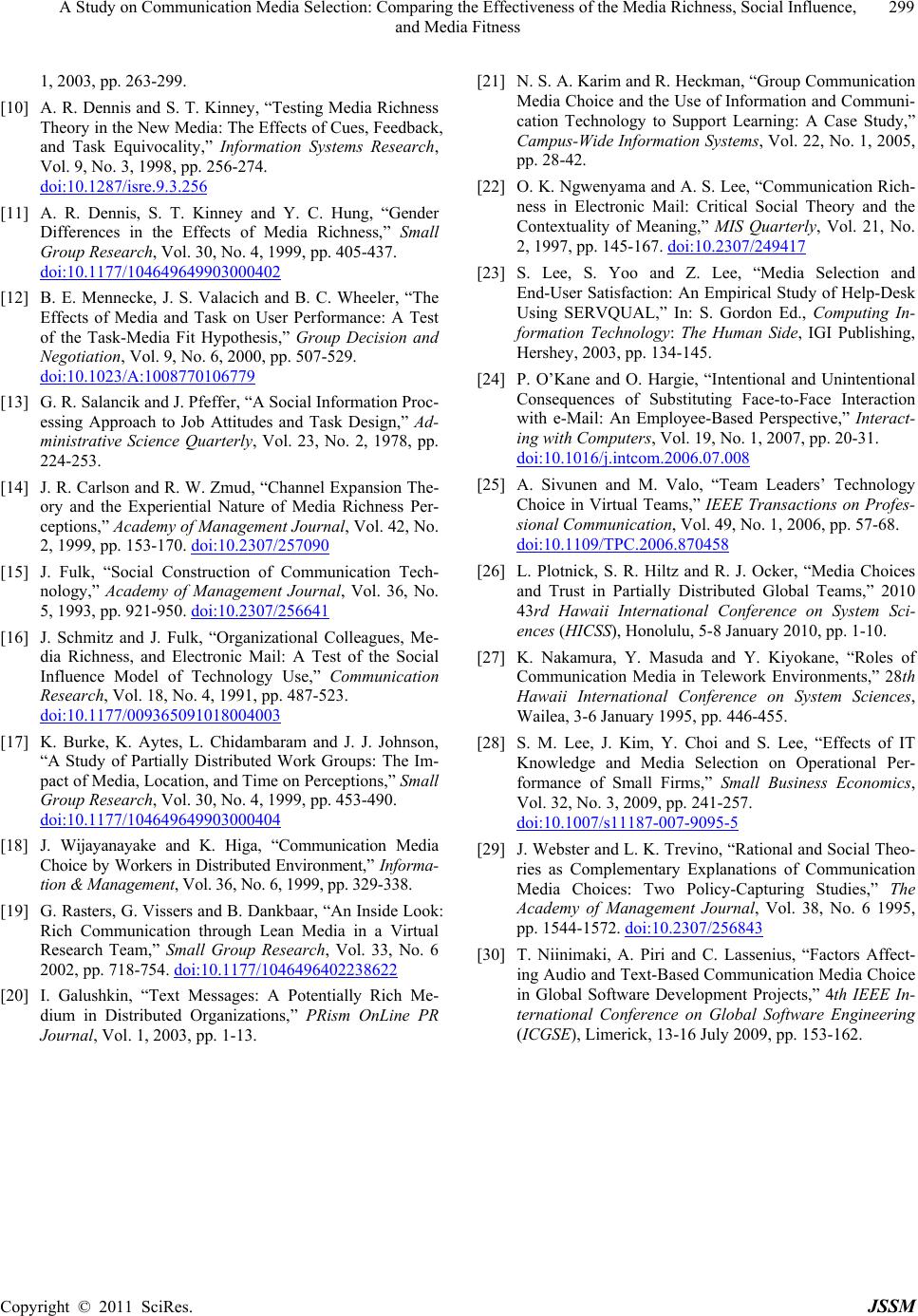 A Study on Communication Media Selection: Comparing the Effectiveness of the Media Ri c hness, Social Influence, and Media Fitness Copyright © 2011 SciRes. JSSM 299 1, 2003, pp. 263-299. [10] A. R. Dennis and S. T. Kinney, “Testing Media Richness Theory in the New Media: The Effects of Cues, Feedback, and Task Equivocality,” Information Systems Research, Vol. 9, No. 3, 1998, pp. 256-274. doi:10.1287/isre.9.3.256 [11] A. R. Dennis, S. T. Kinney and Y. C. Hung, “Gender Differences in the Effects of Media Richness,” Small Group Research, Vol. 30, No. 4, 1999, pp. 405-437. doi:10.1177/104649649903000402 [12] B. E. Mennecke, J. S. Valacich and B. C. Wheeler, “The Effects of Media and Task on User Performance: A Test of the Task-Media Fit Hypothesis,” Group Decision and Negotiation, Vol. 9, No. 6, 2000, pp. 507-529. doi:10.1023/A:1008770106779 [13] G. R. Salancik and J. Pfeffer, “A Social Information Proc- essing Approach to Job Attitudes and Task Design,” Ad- ministrative Science Quarterly, Vol. 23, No. 2, 1978, pp. 224-253. [14] J. R. Carlson and R. W. Zmud, “Channel Expansion The- ory and the Experiential Nature of Media Richness Per- ceptions,” Academy of Management Journal, Vol. 42, No. 2, 1999, pp. 153-170. doi:10.2307/257090 [15] J. Fulk, “Social Construction of Communication Tech- nology,” Academy of Management Journal, Vol. 36, No. 5, 1993, pp. 921-950. doi:10.2307/256641 [16] J. Schmitz and J. Fulk, “Organizational Colleagues, Me- dia Richness, and Electronic Mail: A Test of the Social Influence Model of Technology Use,” Communication Research, Vol. 18, No. 4, 1991, pp. 487-523. doi:10.1177/009365091018004003 [17] K. Burke, K. Aytes, L. Chidambaram and J. J. Johnson, “A Study of Partially Distributed Work Groups: The Im- pact of Media, Location, and Time on Perceptions,” Small Group Research, Vol. 30, No. 4, 1999, pp. 453-490. doi:10.1177/104649649903000404 [18] J. Wijayanayake and K. Higa, “Communication Media Choice by Workers in Distributed Environment,” Info rma- tion & Management, Vol. 36, No. 6, 1999, pp. 329-338. [19] G. Rasters, G. Vissers and B. Dankbaar, “An Inside Look: Rich Communication through Lean Media in a Virtual Research Team,” Small Group Research, Vol. 33, No. 6 2002, pp. 718-754. doi:10.1177/1046496402238622 [20] I. Galushkin, “Text Messages: A Potentially Rich Me- dium in Distributed Organizations,” PRism OnLine PR Journal, Vol. 1, 2003, pp. 1-13. [21] N. S. A. Karim and R. Heckman, “Group Communication Media Choice and the Use of Information and Communi- cation Technology to Support Learning: A Case Study,” Campus-Wide Information Systems, Vol. 22, No. 1, 2005, pp. 28-42. [22] O. K. Ngwenyama and A. S. Lee, “Communication Rich- ness in Electronic Mail: Critical Social Theory and the Contextuality of Meaning,” MIS Quarterly, Vol. 21, No. 2, 1997, pp. 145-167. doi:10.2307/249417 [23] S. Lee, S. Yoo and Z. Lee, “Media Selection and End-User Satisfaction: An Empirical Study of Help-Desk Using SERVQUAL,” In: S. Gordon Ed., Computing In- formation Technology: The Human Side, IGI Publishing, Hershey, 2003, pp. 134-145. [24] P. O’Kane and O. Hargie, “Intentional and Unintentional Consequences of Substituting Face-to-Face Interaction with e-Mail: An Employee-Based Perspective,” Interact- ing with Computers, Vol. 19, No. 1, 2007, pp. 20-31. doi:10.1016/j.intcom.2006.07.008 [25] A. Sivunen and M. Valo, “Team Leaders’ Technology Choice in Virtual Teams,” IEEE Transactions on Profes- sional Communication, Vol. 49, No. 1, 2006, pp. 57-68. doi:10.1109/TPC.2006.870458 [26] L. Plotnick, S. R. Hiltz and R. J. Ocker, “Media Choices and Trust in Partially Distributed Global Teams,” 2010 43rd Hawaii International Conference on System Sci- ences (HICSS), Honolulu, 5-8 January 2010, pp. 1-10. [27] K. Nakamura, Y. Masuda and Y. Kiyokane, “Roles of Communication Media in Telework Environments,” 28th Hawaii International Conference on System Sciences, Wailea, 3-6 January 1995, pp. 446-455. [28] S. M. Lee, J. Kim, Y. Choi and S. Lee, “Effects of IT Knowledge and Media Selection on Operational Per- formance of Small Firms,” Small Business Economics, Vol. 32, No. 3, 2009, pp. 241-257. doi:10.1007/s11187-007-9095-5 [29] J. Webster and L. K. Trevino, “Rational and Social Theo- ries as Complementary Explanations of Communication Media Choices: Two Policy-Capturing Studies,” The Academy of Management Journal, Vol. 38, No. 6 1995, pp. 1544-1572. doi:10.2307/256843 [30] T. Niinimaki, A. Piri and C. Lassenius, “Factors Affect- ing Audio and Text-Based Communication Media Choice in Global Software Development Projects,” 4th IEEE In- ternational Conference on Global Software Engineering (ICGSE), Limerick, 13-16 July 2009, pp. 153-162.
|